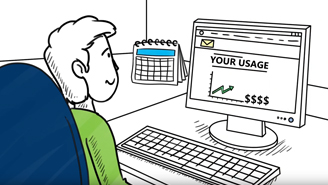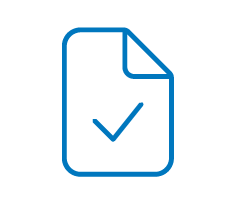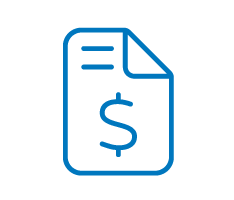Winter Energy Bills Explained
Colder weather means higher bills.
When it’s cold outside, homes use more energy to stay warm. It’s why electric and natural gas bills go up in winter – typically between October and February. We know this can be challenging and we’re here to help.
3 steps to understanding your bill
Step 1: See why winter energy bills are higher.
Our customers are billed for the energy they’ve used. Learn why you use more in winter.

Step 2: See how much energy you’re using.
We bill for energy you’ve used over the past 27 to 35 days. Sign in to see your usage. Non-smart meter accounts can see their monthly usage total. Smart meter accounts can see their daily and hourly usage by appliance. For better results, they can also complete our free online home profile survey. View your usage
Step 3: See your past bills.
Seeing how much energy your home used in the past can help you identify seasonal trends. Sign in to compare by month or year.
Heating raises winter bills. What else does?
When temperatures drop outside, heating makes up 40 to 60 percent of winter energy bills. Learn why and see what else affects winter bills below.
The bigger the difference between outside and inside temperatures, the more your heater will run. During a cold snap, when temperatures drop 10 to 14 degrees below average, homes can use an additional 25 to 50 percent more energy during that timeframe.
- Baseboard, wall and space heaters – These use a lot of energy and can be hard to control. Running one space heater 24/7 can add $100 to your monthly energy bill.
- Only operate baseboard, wall and space heaters in occupied spaces and close doors to unused rooms (as long as freezing pipes are not of concern).
- Make sure nothing is blocking or covering your heaters and vents.
- Wood fireplaces – Although these do not use electricity or natural gas to create heat, it’s important to control the damper to prevent heat loss.
- Close your damper when you’re not using your fireplace to stop warm air from escaping out the chimney.
- Thermostat settings –When it’s 32 degrees outside and you want to maintain 72 degrees inside, that’s a 40 degree difference your heater has to make up for.
- Set your thermostat at 68 degrees and lower it when you’re away or sleeping.
- Lower your thermostat by an additional 3 degrees to save up to 10% more on heating.
- Install a smart thermostat that will adjust automatically and give you control, even when you’re not home.
- Don’t have a thermostat? Use a basic wall thermometer to track how warm your rooms are heating to.
- Maintenance – Old or malfunctioning heating systems can use more energy than necessary.
- Sign up for our furnace filter reminder program and we’ll send you an email reminder when it’s time to change your filter.
- Use our find a contractor tool to find a licensed contractor to help maintain your heating system regularly.
Air leaks are a major source of heat loss. They’ll rob your home of the warmth your heating system worked so hard to produce. A small gap around a door is equivalent to a softball-sized hole in your wall.
- Cracks and gaps – Leaks in ductwork and around windows and doors let warm air out and cold air in.
- Seal leaks around windows with caulk. Removable rope caulk is a non-permanent solution.
- Install weather stripping around exterior doors. Peel-and-stick options are available.
- Install a door sweep or place a rolled-up towel at the bottom of exterior doors.
- Inefficient windows – Old, inefficient windows let heat out and cold in, causing uncomfortable drafts.
- Install removable window plastic on old single-pane, wood-frame, or aluminum-frame windows.
- Install insulated curtains. Use tension rods as a non-permanent solution.
- Install honeycomb shades or consider upgrading to new energy-efficient windows.
- Insufficient insulation – Warm air escapes and cold air sneaks in through walls and ceilings with insufficient insulation.
- Consider adding more wall, attic or floor insulation.
Lights are on more when days are shorter. Now is the time to replace old incandescent or compact fluorescent bulbs inside and outside your home. New LEDs use up to 90% less energy than older bulbs.
- Upgrade to new LED lights.
- Install daylight sensors on outdoor lighting.
More people in your home means more energy usage. Hosting family and friends for the holidays or having kids home on school break results in more cooking, showers, laundry, dishes, electronics and gaming. Holiday decorations use more energy, too.
- Lower your water heater setting to 120 degrees.
- Keep your oven door shut. It loses 20 percent of its heat every time the door is opened.
- Turn electronics and gaming systems off when not in use or after guests leave. Otherwise, they’re always on, even in standby mode.
- Put holiday lights and décor on timers. Running one inflatable lawn decoration 24/7 can add over $5 to your monthly bill.
- Replace old holiday lights with LEDs. One old bulb uses as much energy as 140 LEDs.
Managing your energy usage and costs.
We can’t control the weather, but we can make changes to lower our usage. Learn about ways you can save below.

Do-It-Yourself Tips and Tricks
See quick, easy, low- and no-cost energy-saving ideas completed by Lisa, an Avista customer, in her At Home with Lisa series.

Home Energy Audit
Get personalized insights and recommendations to improve your home's comfort and help you save even more. Plus, it's free.

Rebates and Incentives
We can help you save money on energy efficient home upgrades. Get cash back for adding insulation, installing new windows and doors, and more. Get discounts on new HVAC and water heating equipment, too.
Get help with your winter bills.
From billing and payment plans to adjust your due date or spread your account balance out, to programs and services offered through your local community action agency, we have options.

